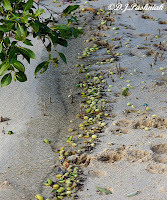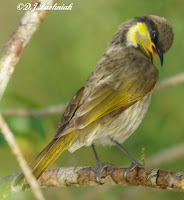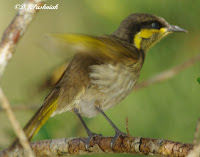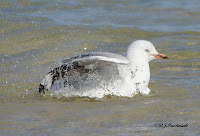Last year a friend challenged me to learn the local mangroves. She said that if I could sort out all the shorebirds (which she apparently finds difficult!) then surely I could manage a few mangrove species. So since then I have been looking at all mangroves more carefully and taking photos to record changes I see.
The Grey Mangrove (
Avicennia marina) is a tall tree (up to 20M) and more open than many of the other mangrove species. This tree is also called the White Mangrove. This is the kind of mangrove that Grey-tailed Tattlers like to roost in as they have a good view around for any danger that may approach.

The tree is notable for the many small pencil shaped breathing roots (pneumataphores) which it sends up all around it and which also extend in lines from the larger underground roots. (The blue color of this photo was a 'trick' of the light caused by the reflection of a very blue sky.)

This year there was a very heavy flowering. The flower is small and a yellowish color. It has a sweet perfume like a very ripe fruit. I had noticed this smell over a number of years as I paddled around one area of the bay but had not connected it to this mangrove flower until this year. There were so many flowers on these trees this year that it was impossible not to notice!

After the flowers the trees set great numbers of fruit.

As they fell from the trees the tides carried them into heaps on the beach.

The fruit lay there until germination opened up the outer casing and where the conditions were right the fruit then embedded itself into the sand and mud. It finally sent down roots and pushed up a stem and opened further into developing leaves. Only a few fruit develop like this and conditions must be right for them to grow further. I have noticed ones that opened and rooted last year and they are still only a few inches high after 12 months. (I don't know why I still think of smaller measurements as inches! About 150-200mm in the other measurement!)





 High up on a tree a male Mistletoebird also completed his morning preen.
High up on a tree a male Mistletoebird also completed his morning preen.
 Out on the saltmarsh flat this Willy Wagtail was catching insects that were hovering over a puddle of water in an old vehicle track.
Out on the saltmarsh flat this Willy Wagtail was catching insects that were hovering over a puddle of water in an old vehicle track. The Scarlet Honeyeaters were already busy in the tops of the trees.
The Scarlet Honeyeaters were already busy in the tops of the trees. The only shorebirds were small dots far out on the sand flats.
The only shorebirds were small dots far out on the sand flats.


























